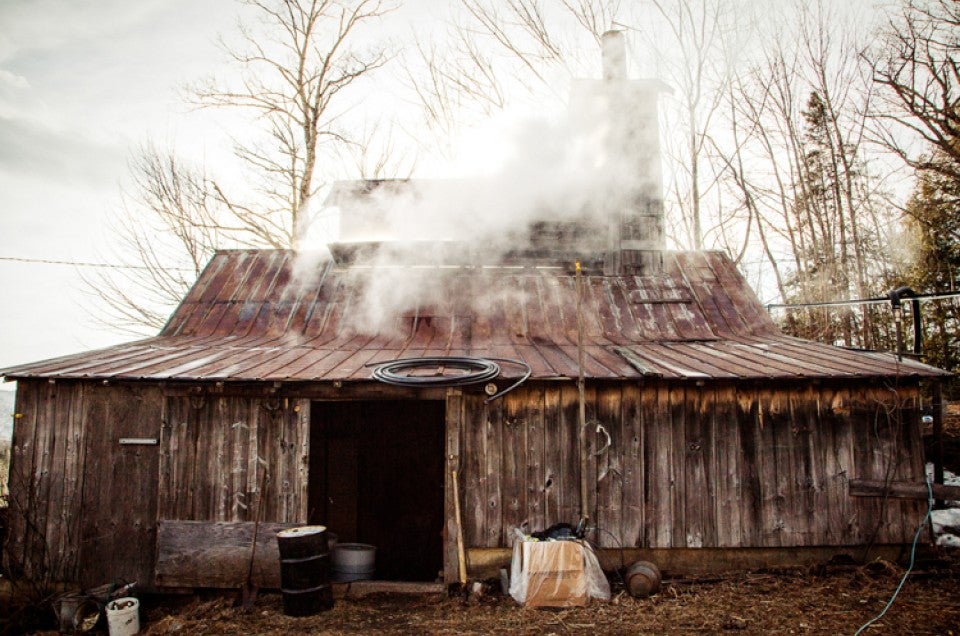


This article originally appeared in the premier issue of King Arthur Flour's Sift Magazine, Spring 2015.
We always visit the sugar makers in spring. For awhile my dad would make his own, in a tiny shack he built on the side of his rickety tool shed in the woods. The floor was open soil, covered by a few precariously placed beams that would tip you into mud if you weren’t especially careful. We’d hard cook eggs in the evaporator and tend the fire, watching patiently as sap slowly turned from sugar water into maple syrup.
It was a cloudy day in early March when we made the trek out to visit Harold and Deedy Hubbard at their sugarhouse in the heart of Rochester, VT. Spring was early, and the winding back-country roads were muddy and pocked with cavernous, tire-shaped ravines.
You always smell the smoke first, laced with the sweet aroma of maple and freshly thawed earth.
Harold’s sugarhouse sits at the base of a field deep in Rochester’s North Hollow, its weathered siding and rusted tin roof a testament to the many winters it's been standing.
Outside, cords of wood are hauled by antique tractor to an opening in the wall...
...where logs are passed through and stacked...
...ready to feed the ever-hungry furnace inside.
Step into the boiling room and you immediately encounter a wall of thick, sweet steam. A handful of bare lightbulbs cast an orange hue over the evaporator, where Harold moves purposefully from one end of the house to the other.
He sees me taking photos of the bulbs and laughs. “I’m pretty sure I remember my father with a kerosene lantern, trying to see what he was doing. We got electric in the house the year I was born, but they must have not wired the sugarhouse until later.”
Deedy tends the gauges, patiently watching the temperature in the pans, and calling the needs of the boil.
“She’s always helped me,” Harold says. “Whatever I needed, whatever she could. All the nuisance-y little things that have to be done but if you concentrate on them you forget what’s happening in the pan. That, and of course, feeding me while I’m stuck out here.”
Lines and pumps have replaced the old bucket collection system I remember as a kid. Harold is glad for that. He remembers the old days when he and his father Stanley Hubbard would trudge into the woods and empty buckets into a tank attached to a horse-drawn sleigh. It was a larger operation then, with many more hands required to share the load.
The inside of the family sugarhouse – over 100 years old – bears the names of as many men who have worked there over the years. Important dates are recorded as well – the first boil of each season, memorialized in wax pencil on the wooden walls.
I ask Harold why he still does it, after all of this time. “Obviously, the income,” he admits, but “it fills the end of the winter, when everyone else has cabin fever.”
I ask how he feels about visitors and he tells me the sugarhouse is always open. “I don’t like to have a lot of people around, but I do enjoy the company... just don’t ask me any stupid questions.”
He chuckles, and I ask him about the best one he’s ever gotten. “Well, the perennial one that everyone’s heard is about the guy who asked me when you add the maple sugar. One year, sugaring all came in 8 days. I had a guy in here snapping pictures and asking questions – the topic of how it was a lot of work came up – and I said ‘Yeah, I’ve already worked 70 hours this week,’ and he said ‘Oh yeah, where do you work?’ I didn’t ask him to stick his head in the furnace or anything, but I was pretty tempted.”
Business has changed over the years and Harold’s operation has changed along with it, but many things remain the same.
Harold replaced the dirt floors in 2002. “I was sick of playing in the mud,” he says.
The pans are covered now, and of course the technology has evolved greatly since he first began. But at the heart of it, the process of making syrup – adding heat to sap until reduced – hasn’t really changed at all.
I ask if Harold thinks his kids will take over the business one day, and he says he isn’t sure. “All I’m hoping to do is hold out here long enough for them to have a choice.”
It’s dusk when we fill our mason jars with syrup and start back down the winding dirt road towards home. In a few short weeks the season will be over; the trees will bud and the valleys will begin to return to life. We say our goodbyes and I take one last breath of the damp air, heavy with the smell of wood smoke and tradition.
If you'd like to catch up on stories you may have missed in Sift, check out back issues of the magazine.














